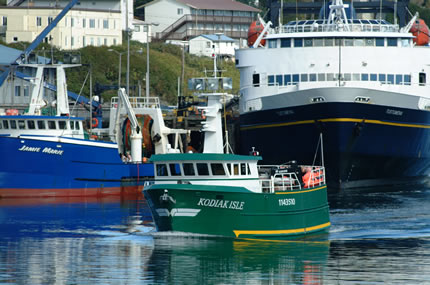About the Scenic Byways Program
Themes: Byway Intrinsic Qualities
A byway can be designated under one or more of the six "intrinsic qualities" defined by the Federal Highway Administration listed below. Please note that even though all designated routes are called "scenic" byways, the route may have been designated for outstanding historical qualities rather than scenic qualities.
Archaeological
Archaeological Quality involves those characteristics of the scenic byways corridor that are physical evidence of historic or prehistoric human life or activity that are visible and capable of being inventoried and interpreted. The scenic byway corridor’s archeological interest, as identified through ruins, artifacts, structural remains, and other physical evidence have scientific significance that educate the viewer and stir an appreciation for the past.
 Ferries and fishing boats mingle along the Alaska Marine Highway "All-American Road" in Kodiak.
Ferries and fishing boats mingle along the Alaska Marine Highway "All-American Road" in Kodiak.credit: Peter Metcalfe, Alaska DOT&PF
Cultural
Cultural Quality is evidence and expressions of the customs or traditions of a distinct group of people. Cultural features including, but not limited to, crafts, music, dance, rituals, festivals, speech, food, special events, vernacular architecture, etc., are currently practiced. The cultural qualities of the corridor could highlight one or more significant communities and/or ethnic traditions.
Historic
Historic Quality encompasses legacies of the past that are distinctly associated with physical elements of the landscape, whether natural or manmade, that are of such historic significance that they educate the viewer and stir an appreciation for the past. The historic elements reflect the actions of people and may include buildings, settlement patterns, and other examples of human activity. Historic features can be inventoried, mapped, and interpreted. They possess integrity of location, design, setting, material, workmanship, feeling, and association.
Natural
Natural Quality applies to those features in the visual environment that are in a relatively undisturbed state. These features predate the arrival of human populations and may include geological formations, fossils, landform, water bodies, vegetation, and wildlife. There may be evidence of human activity, but the natural features reveal minimal disturbances.
Recreational
Recreational Quality involves outdoor recreational activities directly association with and dependent upon the natural and cultural elements of the corridor’s landscape. The recreational activities provide opportunities for active and passive recreational experiences. They include, but are not limited to, downhill skiing, rafting, boating, fishing, and hiking. Driving the road itself may qualify as a pleasurable recreational experience. The recreational activities may be seasonal, but the quality and importance of the recreational activities as seasonal operations must be well recognized.

Hikers stop for lunch on the Pinnell Mountain Trail off the Steese Highway. Credit: Craig McCaa, BLM
Scenic
Scenic Quality is the heightened visual experience derived from the view of natural and manmade elements of the visual environment of the scenic byway corridor. The characteristics of the landscape are strikingly distinct and offer a pleasing and most memorable visual experience. All elements of the landscape—landform, water, vegetation, and manmade development—contribute to the quality of the corridor’s visual environment. Everything present is in harmony and shares in the intrinsic qualities.
